|
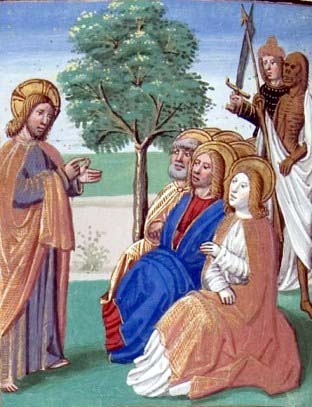
Jesus teaches not to fear death (Vol. 2, folio
40v) |
Our copy of Ludolf of Saxony's Vita Christi is a prime example of a high-quality 15th century manuscript.
A detailed exploration of the manuscript and its skilled
craftsmanship may help us to understand the past. As an
artefact of immense cultural importance, it provides evidence of the basic
beliefs and artistic values of late medieval society.
When we first look at a page in an illuminated manuscript,
however, its layout may appear confusing and difficult to understand.
Therefore, before beginning our examination of this book, let us
alleviate any anxieties by analysing a typical page to clarify
the standard sections and explain the terminology. |
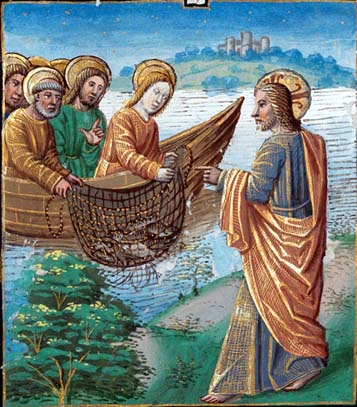
The miraculous catch of fish
(Vol. 1, folio
134v) |
| As our example, we will use a page from volume one of our copy of the Vita Christi.
This is folio 20r. Folio (fol. or f.) is Latin
for 'leaf'; it is the sheet of
material for writing on. Medieval manuscripts were commonly made by
gathering together folded sheets of animal skin (vellum or
parchment) to form individual quires that were stitched
together to make a book, protected by a covering (binding). Many manuscripts are numbered according to the
'leaf' and not individual pages, hence
the term foliation. A folio consists of two sides (or pages):
the recto (r) is the front side of a folio and the
verso (v) is the back side of a folio. In this
manuscript layout, most pages have been divided into two columns
(col.). To help in referring to specific lines of text,
the columns are differentiated by designating the left-side of the
leaf as column a and the right-side of the leaf as column
b.
A miniature is a drawing or illustration in a manuscript.
Contrary to our usual understanding of the term 'miniature' relating
to something small, these illustrations do not follow specific size
guidelines. For example, a miniature might be a section of one
column as seen in the Annunciation scene here, but it can also be a
full page or half page illustration as seen in examples below (for
example, the Nativity miniature). The word 'miniature' in relation
to manuscripts comes from the Latin 'miniare' meaning to colour with
red. An illuminated illustration is when metal (usually gold
or silver) is used as part of the colouring scheme.
The main features of this page include:
A: a miniature depicting the Annunciation (folio 20r, col. B)
B: a decorated bar known as a line filler
C: a rubric (ie. in red) or rubricated text; the titles, chapter
headings, and other instruction are usually written in red to make them
stand out
D: a decorated initial 'O' that helps to signal the start of
a new section of text
E: the standard script (in this case, a French Bastard hand)
F: Heraldic border decoration, using the Fleur-de-lys, the
symbol of the French Monarchy
G: a foliate border, incorporating flowers and fruit
|
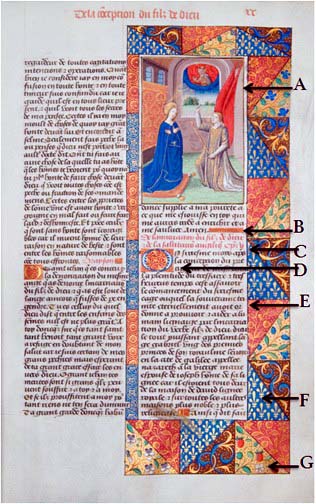
The Annunciation (Vol. 1, folio 20r) |
|
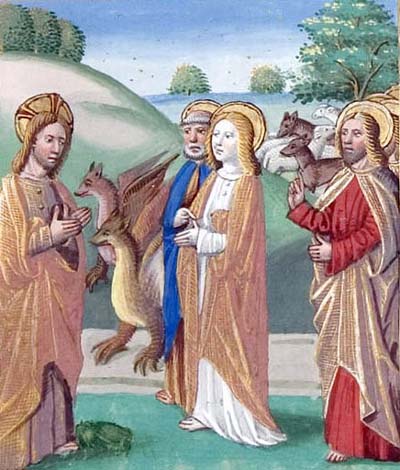
Jesus teaches patience (miniature detail from Vol.
2, folio 34v) |
Throughout the medieval period, the desire to live a spiritual
life was a basic belief of paramount importance. A personal
connection with God could be formed by prayer and devotional study.
The Vita Christi text was one of many works that could be
used as an instructional manual for religious devotion. Its aim was to stimulate thoughtful reflection.
Through prayer and meditation, it teaches how to lead an ideal and
pious life. The title 'Life of Christ' can therefore be
misleading. Although the work does document the chronological life
of Christ as a whole, it is not a simple biography from his birth to
his ascension; rather, it is an historical commentary woven with
theological insight, life instructions, meditations and prayers. |
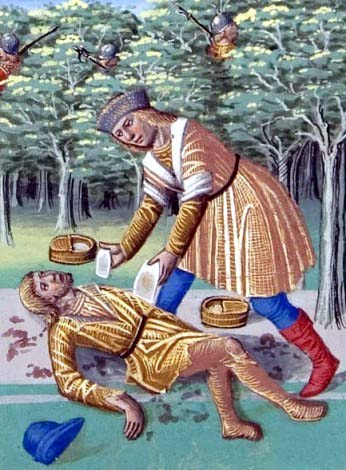
The good samaritan (miniature detail from Vol. 2,
folio 72r) |
|
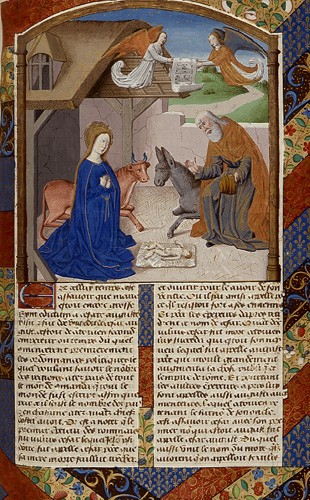
The Nativity
(miniature from Vol. 1, folio 44r)
|
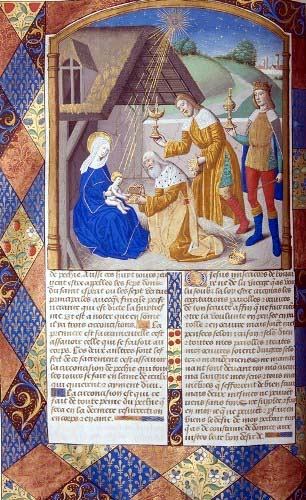
The Epiphany
(miniature from Vol. 1,
folio 55v) |
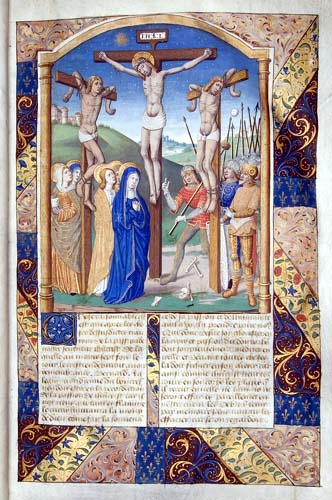
Crucifixion
(miniature from Vol. 4, folio 1r) |
|
A well-rounded piece of spiritual literature, the
Vita Christi draws heavily upon the Gospels, but also
incorporates other writings from ecclesiastical authors such as
Augustine, to secular philosophers such as Cicero. Appropriately for
this time of year, the Christmas story is given prominence in
series of half page miniatures. |
|
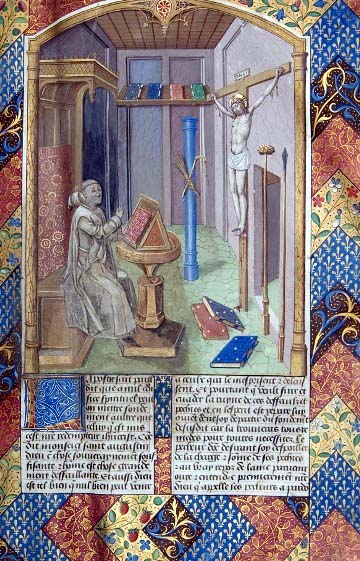
The author with Christ (Vol. 1, folio 1r) |
The Vita Christi was a very popular work in the 15th
century. There are many versions of the text, in a variety of
languages, adapted by different authors. Numerous manuscript (and
early printed book) copies of it from the late medieval period
survive. Our manuscript is a version of the work by Ludolf of
Saxony (d.1378). Also known as Ludolphus of Saxonia or Ludolf
the Carthusian, Ludolf was a 14th century ecclesiastical scholar and
writer. He first entered the Dominican order before becoming a
Carthusian thirty years later. Despite the addition of "Saxony" to
his name, it would be remiss to make the assumption that this was
his native land.
Often referred to as a summa
evangelica (summa from the Latin 'highest' and 'evangelica'
pertaining to the Gospels), Ludolf's version of the Vita Christi
text is one of the most comprehensive; it brings together the
writings of approximately sixty authors.
It was deliberately written in a straight forward style that is
easy to comprehend. It was essential for the reader to understand
the text in order to achieve its aim of increasing spiritual
understanding on the road to piety. As Bodenstedt states, the
"wholesome means for spiritual progress offered to the readers of
the Vita is a clue to its popularity; Ludolphus taught them
the fundamental principles of the ascetical life in concrete and
appealing fashion"1.
Ludolf also added prayers to the text to assist the reader with
spiritual devotion. These are positioned at the conclusion of each section
or chapter to
encourage the reader to reflect on the previous passage. |
|
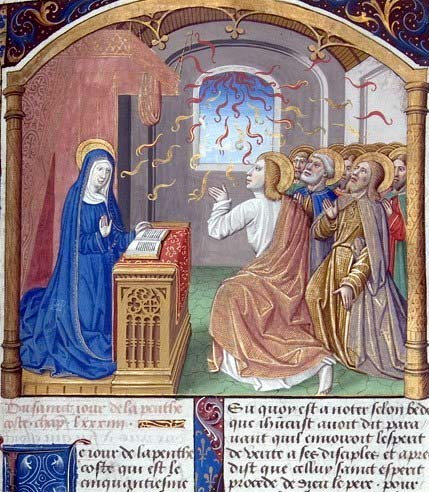
The Pentecost (Vol. 4, folio 219r) |
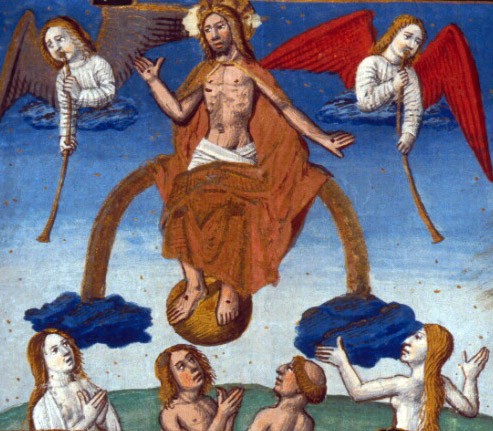
The Last Judgement
(miniature detail from Vol. 3, folio 169r) |
|

Monk in white robes
(Vol. 3, folio 47v) |
| Ludolf's profound belief in the power of
prayer is particularly commented on by Bodenstedt: "His treatment of it
[prayer] includes mental, vocal, public, and private prayer. He
believed that meditation on the Life of Christ is the real
foundation of Christian perfection... The prayers which represent a
résumé of the meditations in the Vita are appropriate for the many
varying circumstances of the spiritual life. Consonant with the
objective of the Vita, they entreat the grace to imitate
Christ"2.
This version of Ludolf's text was translated from Latin
into French in Paris
during the 1490s by Guillaume le Ménard, a Franciscan cleric.
Our manuscript is a de-luxe production of the highest
class. Written on good quality vellum, it comprises of four
weighty volumes. A book of such a size would have been time
consuming and expensive to produce.
|
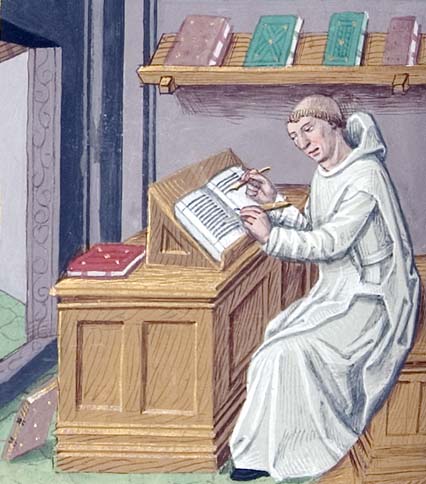
Detail of monk
writing a manuscript
(Vol. 3, folio 47v) |
|

Detail of script (Vol. 1, folio 134v)
|
| It is carefully written out in the hand of one
scribe who uses a French Bastard script, typical of the late
15th century. |
|
|
There are 140 miniatures in total throughout the four volumes of the
manuscript. While many represent traditional biblical renditions
such as The Transfiguration (below), much of their appeal lies in
those that depict intimate, domestic scenes such
as Mary Weaving with Jesus at her Feet (to the right). They are attributed to the artist
Jacques de Besançon,
who was Chief Associate of the royal painter Maître François.
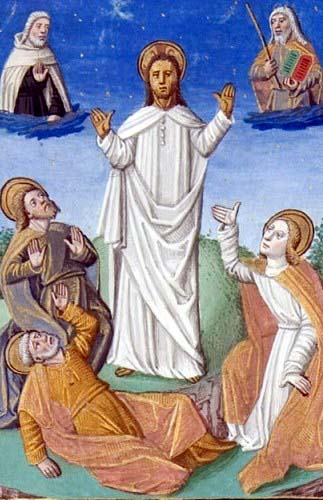
The transfiguration
(detail of miniature
from Vol. 3, folio 10v) |
|
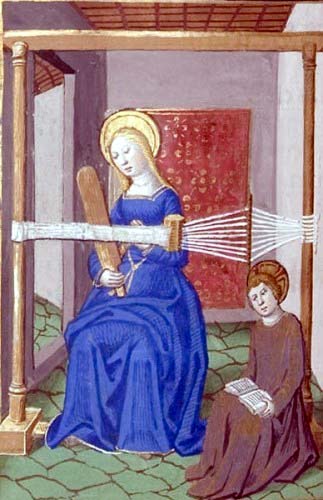
Mary weaving with Jesus at her feet
(detail of miniature from Vol. 1, folio 80v)
There has been some dispute in the past regarding
Besançon's contribution to the manuscript and whether or not he was
exclusively responsible for the miniatures and (possibly) border
art. However, the height of his career activity - between 1485
through to the 1490s - corresponds with the approximate date of its
production. The alternate idea is that Maître François himself had an
artistic hand in the miniature painting. Besançon took over the
François workshop in 1480, leaving both artists active when our
manuscript was created. François and Besançon worked with similar
composition and formatting styles; their similarities leave us
questioning if they both worked on our Vita Christi.
|
|
| Certainly, the illustrations are of exceptional quality. The
colours are vibrant to this day and gold has been used extensively
to illuminate the scenes. The miniature of the Annunciation
is a good example of the varied use of gold illumination. In this
scene, Mary is being informed by the Angel Gabriel that she is to
give birth to Christ. The gold is found in finite detail
on the tapestry background behind Mary. Her halo, meanwhile, is an
example of a larger filled area of gold. Gold is also used to pick
out the folds of the Angel Gabriel's garment and his speech, while
heavenly golden rays of glory convey a sense of the privilege being
bestowed upon Mary.
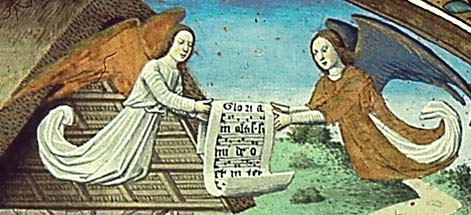
Detail from the Nativity
(miniature from Vol. 1, folio 44r)
The miniatures are finely detailed. A good example of the level
of detail found may be seen in the illustration of the Nativity.
Hovering above the humble stable where Christ has been born are two
angels. They carry a sheet upon which can clearly be seen both musical notes and the
Latin inscription "Gloria in altissimis deo et in ter ...". |
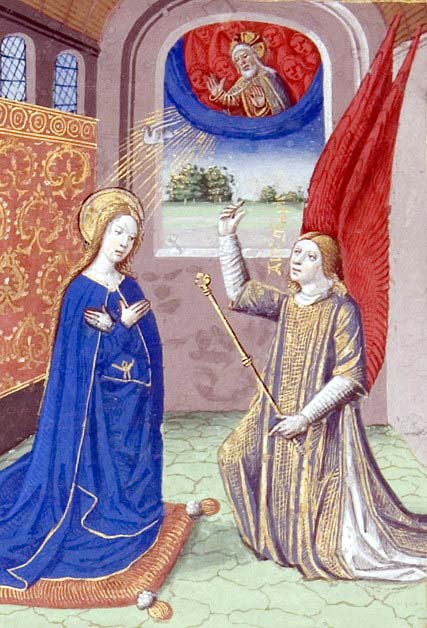
The Annunication (detail of miniature from
Vol. 1, folio 20r) |
|

Border art example
(Vol.1,folio 144) |
Many of the illustrations are surrounded by intricate
decorated borders. Such a border on all four sides of a
miniature stresses the importance of the image in the
manuscript. This floriated (flower-like) border art found
has a beautiful vibrancy that adds to the quality and
distinction of the manuscript.
|
|
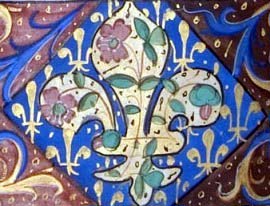
Border art example
(Vol.3,folio 47v)
|
Most of the borders are formulated in
geometric patterning with clearly defined outlines. There are some borders that break the
mould, with
free-form organic shapes as opposed to geometric. A prime
example is the fleur-de-lys outline placed inside a
geometrically formed margin. In our manuscript the golden
fleurs-de-lys motif changes structurally throughout the volumes.
|

Border art example
(Vol.1,folio 20)
|
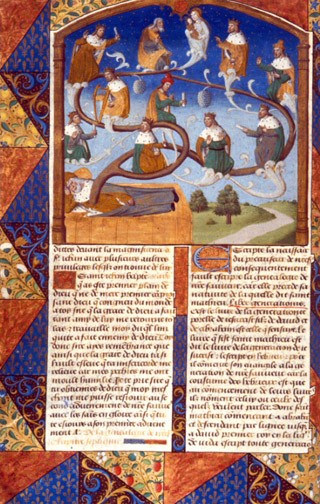
Christ's genealogy from Adam (Vol. 1, folio
36?) |
Perhaps sometimes overlooked in favour of miniatures,
borders used in illuminated manuscripts may provide historical information as
well as artistic beauty. In some instances, their analysis can
help to date a manuscript or provide clues about its place of
origin.
Borders could be executed via a template or free hand, and if
the artist changed throughout production this could be an
explanation for any stylistic differences found.
The exquisite detail and luxurious quality of work found
throughout this manuscript indicates that it must have been
created for a wealthy and important patron. In fact, our
manuscript is a presentation copy that was made for Charles VIII
(1470-1498), the King of France. There is even an inscription at
the beginning of each volume that states "por le roy" or "for
the king." In some of the illustrations, Saint John is made
prominent, and his youthful features resemble those of Charles
VIII.
| The lower border of the dedication contains a detailed image of
the modern (after 1376) royal French heraldic crest. It consists of
three golden (or) fleurs-de-lys upon a blue (azure) shield. The French crown rests
on top of the shield that is being supported by two kneeling
angels. |
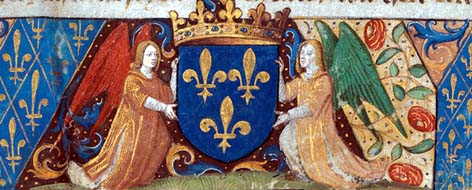
Detail of heraldic crest in the border of
the dedication page |
|
|
| Charles VIII, 'the affable', reigned from 1483
to 1498. The young
king was crowned at a time of instability in French history. At the
same time, religious devotion was of the highest importance.
As Knecht states, "Charles became king at a time of intense religious fervour prompted
by the approach of the 'millennium', which prophets and astrologers
were proclaiming to be imminent. At the close of the 15th century religious faith remained one of the most effective 'media'
of political action"3. At such a time of significant religious fath,
ownership of a devotional work such as the Vita Christi
was entirely fitting. For Charles to have such a fine copy of
the book dedicated to him emphasizes his importance as an individual as well as his
desire to uphold his faith. The first illustration in volume one
of our manuscript copy of the Vita Christi depicts the
dedication of the book to Charles VIII. This scene shows
the spiritual devotion of Charles. He is depicted kneeling reverently at his prie-Dieu;
French for "Pray [to] God", a prie-Dieu is a small wooden prayer desk
that incorporates a shelf
for books and a kneeler. The king is about to take confession
from the ecclesiastic kneeling on the opposite side of the
prie-Dieu. The attendant behind Charles has placed his hat
behind him to show reverence for both King Charles and Christ;
he is holding a bound book to be presented to Charles - possibly
one of the volumes of the Vita Christi.
The
devotion of Charles is witnessed by several onlookers, including
three cardinals
dressed in their traditional red robes. Public figures
witnessing Charles' devotion to God promote the understanding
that he is a deserving and righteous leader whose decisions will
be governed by God. The private act of prayer and devotion takes
on public appeal.
|
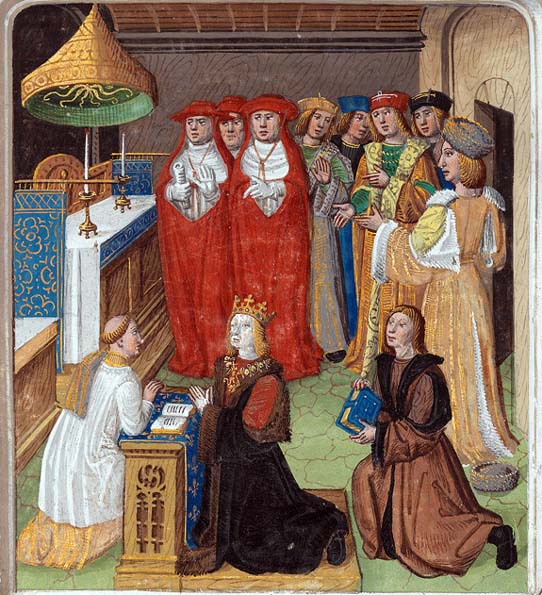
Detail of dedication miniature
(preliminary page) |
|
|
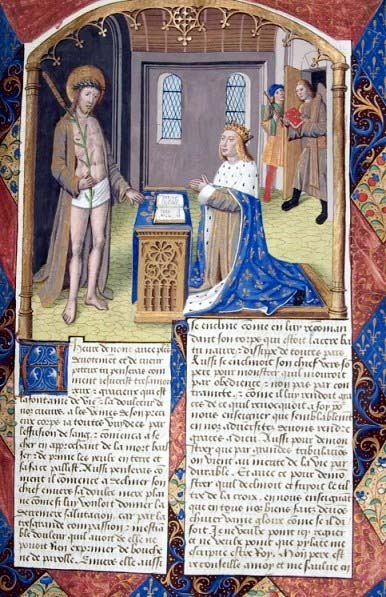
Christ appearing to Charles VIII (Vol. 4 folio 97r) |
Charles VIII's reign was blighted by certain
negative events that would have initiated a need in him to
proclaim his devotion and a commitment towards pious living. For
instance, he was condemned as an adulterer by Maximilian I
of Hapsburg after a marriage contract concerning his daughter,
Margaret of Austria, fell through. Margaret was only three at the
time of the accusations, so the consummation of the marriage
was inconceivable. A papal
dispensation and subsequent annulment were granted.
If this
manuscript was created after the rumours of adultery came out,
our Vita Christi would have been an asset in showing the French
court and the public Charles' reformed and piteous ways.
Another illustration that emphasises Charles' piety is his
vision of the Crucified Saviour in volume 4 of our manuscript.
Of interest is a figure in the upper right of the picture.
Holding a crimson bound volume, he is thought to be the French
translator Guillaume le Ménard.
The fine detailing in many of the illustrations has already
been mentioned. The clothing and textiles in particular are
executed with such precision that the folds and drapery of the
cloth appear true to life. The patterning and texture of the
clothes also help the reader to identify key persons through the
richness of their garments; in the illustration here, for
example, Charles VIII is easily recognisable both from the crown
he wears and from the opulence of his ermine lined mantle. While
Charles does not have a sceptre, Christ does (albeit fashioned
out of reed). Charles connects with Christ just as Christ
connects with the King. |
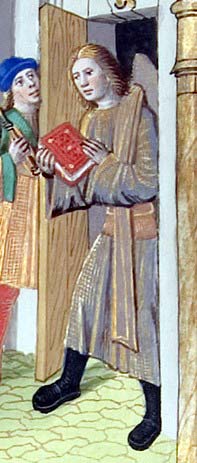
Detail from miniature of Christ
appearing to Charles VIII,
possibly depicting the translator
Guillaume le Ménard
(Vol. 4 folio 97r) |
|
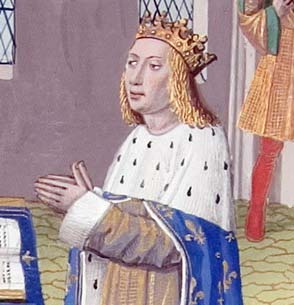
Detail showing Charles VIII (Vol. 4 folio 97r) |
King Charles is portrayed kneeling in
pious reverence at his prie-Dieu. It is draped in the same blue cloth
with the royal fleur-de-lys as seen in the Dedication image. The
heraldic crest also continues to manifest itself in the wardrobe of
Charles; it appears on his robe. At the base of King Charles' attire
is a slate and gold sleeved mantle with pronounced white cuffs. The
slate and gold mantle is also worn by Christ and Guillaume le
Ménard. This unifying garment linking Charles and Ménard with Christ
portrays them as spiritual individuals. |
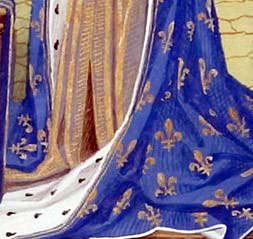
Detail showing Charles VIII's robe
(Vol. 4 folio 97r) |
|
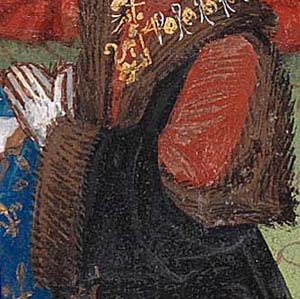
Detail of King's robe from Dedication |
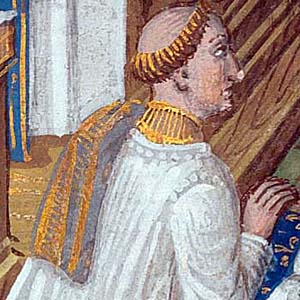
Detail of the King's Confessor's robe from
Dedication
|
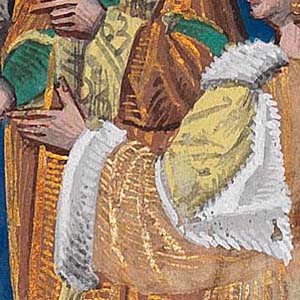
Detail of bystanders robes from Dedication |
| Charles' wealth is demonstrated via the expense of his
fabrics; in the Dedication image, he wears a crimson doublet and
black velvet slash-sleeved mantle trimmed with sable - another
highly-valued fur. His confessor, meanwhile, is dressed in a
surplice with a cloth of gold draped over his left shoulder.
|
|
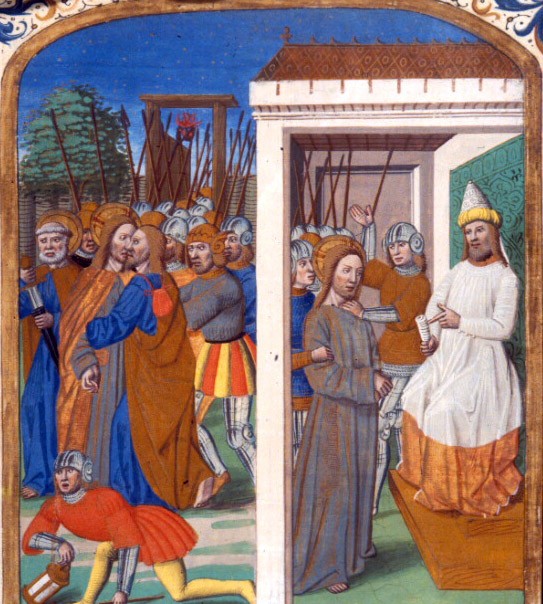
Detail of miniature of Judas betrayed
(Vol. 4, folio 29v) |
Our copy of the Vita Christi may be interpreted as a
concrete manifestation of Charles' quest for religious devotion.
It is a manuscript with physical and spiritual density
that is both a tool and showpiece. The Vita Christi is
timeless. As Bodenstedt states, Ludolf's prayers "have been used by many in the past
and they are fresh even today. Through them the Vita still yields
its unction."4
As a manuscript for all seasons, we are privileged to have such
a precious copy in our collection. It is now part of the Library's
Hunterian Collection.
It was purchased for William Hunter at the sale of the library of
Louis-Jean Giagnat in Paris 1769 and transported to London. It
subsequently came to the University of Glasgow with the rest of
Hunterian bequest in 1807.
Two volumes of this exquisite book will be on display in the
Special Collections foyer from December 2009 to February 2010.
|
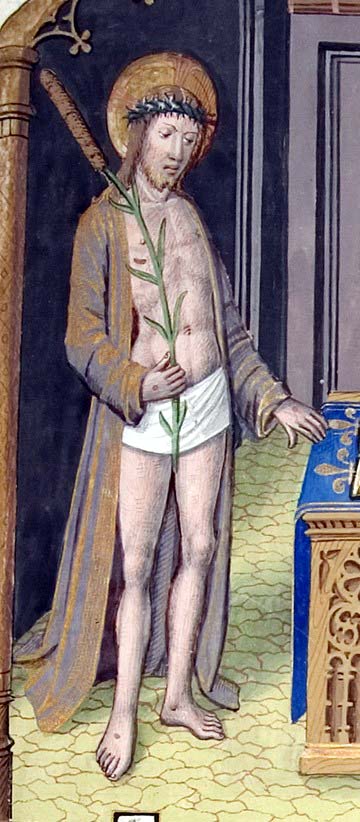
Detail of Christ from miniature of Christ appearing
to Charles VIII (Vol. 4, folio 97r) |
Other items of interest:
Other 15th century decorated French manuscripts in Special
Collections:
Boccaccio De Casibus Virorum Illustrium (The Fall of Princes)
Paris: 1467. Sp Coll MSS Hunterian 371-372. See
February 2009 book of the month.
Paolo Emilio (Aemilio) In Franciae Antiquitatem Libri Tres
(Treatise on French Antiquities) France: 1490s. MS Hunter 98
(T.4.15)
Paolo Emilio (Aemilio) Galliae Antiquitates (Antiquities of
France) France: 1480s-1490s. MS Hunter 11 (S.2.1)
Albertus Magnus (pseudo) Liber Lapidarius (Lapidary) France:
mid 15th century. MS Hunter 468 (V.6.18)
Guillaume de Nangis Chroniques de Saint-Denys (Chronicles of
Saint-Denis) France: 3rd quarter of the 15th century. MS
Hunter 203 (U.1.7)
Seneca Tragoediae (Tragedies) France: 1490s. MS Hunter 322
(U.7.16)
Guillaume Tardif Fauconnerie (The Art of Falconry and The Art
of Hunting) France: c. 1494 MS Hunter 269 (U.5.9)
The following have
been useful in creating this article:
Avril, François and Reynaud, Nicole Les Manuscrits
Peintures en France Paris: Flammarion-Bibliothèque nationale de
France, 1995. Level 11 Fine Arts : Bibliography qB162:24 1995-A
Bodenstedt, Sr. Mary The Vita Christi of Ludolphus the
Carthusian Washington D.C.: The Catholic University of America
Press, 1944 Library Research Annexe Store C8-Kll
British Library 'The style of the Master of Jacques de
Besançon'
(http://www.bl.uk/catalogues/illuminatedmanuscripts/TourPopup.asp?TourID=149)
Page accessed 15 March 2009
Brown, Michelle P. Understanding Illuminated
Manuscripts: A Guide to Technical Terms California: Getty
Publications, 1994.
Clarke, Michael The Concise Dictionary of Art Terms
Oxford: Oxford University Press, 2003
Knecht, Robert Jean The Valois: Kings of France
1328-1589 London: Hambleton and London, 2004. History LC 100. V3 -
KNE
Linder, Amnon 'An Unpublished "Pronosticatio" on the
Return of Charles VIII to Italy' Journal of the Warburg and Courtauld
Institutes, Vol. 47 (1984), pp. 200-203.
Marrow, James H., 'Symbol and Meaning in Northern
European Art of the Late Middle Ages and the Early Renaissance'
Simiolus: Netherlands Quarterly for the History of Art, Vol. 16, no.
2/3 (1986), pp.150-169.
Parkes, M. B., Scribes Scripts and Readers: Studies
in the Communication, Presentation and Dissemination of Medieval Texts
London: The Hambledon Press, 1991. Level 11 Fine Arts: Bibliography B144
1991-P
Plummer, John The Last Flowering: French Painting in
Manuscripts 1420-1530 New York: The Pierpont Morgan Library, 1982.
Level 11 Bibliog B 162:24 1982-P
Randall, Lilian M. C. Images in the Margins of Gothic
Manuscripts California: University of California Press, 1966. Level
11 Fine Arts: Bibliography (QUARTOS) B 162 1966-R
Rorimer, James T. 'The Glorification of Charles VIII'
The Metropolitan Museum of Art Bulletin New Series, Vol. 12, no. 10
(June 1954), pp. 281-299.
Sainty, Guy Stair World Orders of Knighthood and
Merit United Kingdom: Burke's Peerage & Gentry,
2006.
Sandler, Lucy Freeman The Psalter of Robert de Lisle
in the British Library London: Harvey Miller Publishers, 1982. Level
11 Fine Arts: Bibliography qB 162:10 1982-S
Scott, Kathleen L. Dated & Datable English Manuscript
Borders c. 1395-1499 London: The Bibliographical Society, 2002.
Level 11 Fine Arts: Bibliography B 162:10 2002-S
Scheller, Robert W. 'Imperial Themes in Art and
Literature of the Early French Renaissance: The Period of Charles VIII'
Simiolus: Netherlands Quarterly for the History of Art Vol. 12,
no. 1 (1981-1982), pp.5-69.
Shailor, Barbara The Medieval Book Toronto:
University of Toronto Press, 1991. Level 11 Fine Arts: Bibliog B140
1991-S
Thorp, Nigel The Glory of the Page: Medieval and
Renaissance Illuminated Manuscripts From Glasgow University Library
London: Harvey Miller Publishers, 1987 Level 11 Fine Arts: Bibliography
B 162 1987-U
University of Glasgow Library Special Collections
manuscripts catalogue entry for MS Hunter 36-39
(http://special.lib.gla.ac.uk/manuscripts/search/detaild.cfm?DID=32440)
Page accessed, 14 March 2009.
Valentine, Lucia, Ornament in Medieval Manuscripts
(London:
Faber and Faber, 1965). Level 11 Fine Arts: Bibliography B 160 1965-V.
References cited in text
1. Bodenstedt, p. 148
2. Bodenstedt, p. 148
3. Knecht, p. 121
4. Bodenstedt, p.148
Return to main Special Collections
Exhibition Page
Go to previous
Books of the Month
Kelly Le Blanc December 2009
[article originally written in 2009 as part of a work
placement in Special Collections arranged as part of an M
Litt course in the History of Art] |